Is it perplexing when navigating the supermarket aisle and deciding which oil to purchase for the better health of yourself and your family? Additionally, it’s disheartening how Groundnut oil is being unjustly criticized for its alleged weight-gaining properties.
However, is that all the “King of oilseeds” has to offer? Countless tales circulate about how oil consumption has negatively impacted someone’s health, leading us to avoid oil altogether in the name of “dieting.”
So, let’s commence with this article that aims to dispel myths and guide you in selecting the best oil for your consumption.
The Power of Groundnuts
Despite being commonly referred to as a nut, groundnuts are legumes, similar to beans or peas.
Groundnuts are not just a snack during leisure time but also have various everyday uses.
Being one of nature’s most nutritious seeds, groundnuts are widespread cultivation crops in almost 100 countries across all six continents.
They play a significant role in industries, as they are a part of the production of oil, beverages, flour, protein concentrates, and sweet candy.
The attention they receive is for their edible oil and protein-rich meals, which hold significant nutritional value for both humans and animals.
Their distinctive flavour and low presence of anti-nutritional factors make them a versatile snack, limited only by one’s imagination and creativity.
Prominence and Production of Groundnuts in India
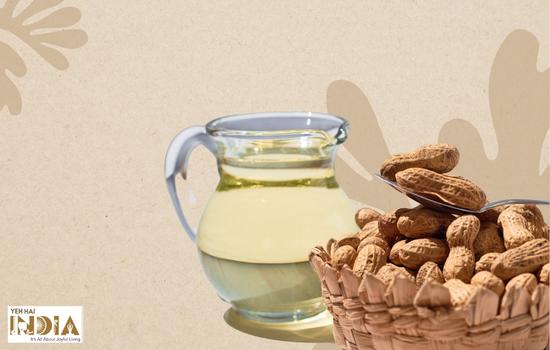
India holds a significant position in the global agricultural economy as one of the largest producers of oilseeds. Amongst the various oilseeds, groundnut is often referred to as the “King” due to its prominence.
Key groundnut-producing countries include India, China, Nigeria, Senegal, Sudan, Burma, and the United States of America.
The cultivation of groundnuts in India is majorly in four states: Gujarat, Andhra Pradesh, Tamil Nadu, and Karnataka, which account for 70% of the area and 75% of the production.
Within the industry, groundnut oil finds diverse applications. It is a raw material for manufacturing pharmaceuticals, soaps, hair creams, cosmetics, dyes, paints, lubricants, and emulsions for insect control.
Groundnut Oil – Versatile Applications
Groundnuts, also known as peanuts, are immensely important as oil-bearing seeds and serve as a valuable source of plant protein. Groundnut oil, with its high energy and fat content, can be consumed raw, boiled, or roasted for immediate consumption.
The use of groundnut oil in cooking goes back to ancient times, and it is challenging to pinpoint a specific individual or culture that discovered its culinary applications.
The indigenous people of South America, such as the Incas and the Aztecs, were among the early cultivators of groundnuts. They likely recognized the oil content of groundnuts and started utilizing it for cooking purposes.
Recommended Article: The Almond Guide – Decoding the King of Nuts
As groundnuts spread through trade and exploration, their culinary uses and the extraction of their oil became known to various cultures and regions. Over time, different societies and culinary traditions across the globe incorporated this oil into their cooking practices.
It is important to note that the discovery and utilization of groundnut oil in cooking likely occurred gradually and collectively among different communities over a long period. The process involved experimentation, observation, and cultural exchange rather than a specific individual or moment of discovery.
What does Ayurveda have to say about it?
The use of Groundnut oil is not only popular among Nutritionists and Scientists but also in Ayurveda,
- In Ayurveda, groundnut oil is believed to balance Vata and Pitta doshas. It is considered warming and grounding, benefiting those with Vata imbalances. The cooling effect of this oil can help alleviate heat and inflammation in Pitta dosha.
- It aids digestion, stimulates the digestive fire, and promotes nutrient absorption.
- It moisturises and nourishes the skin.
- As an Ayurvedic massage oil, it relieves joint pain and inflammation.
- This oil is also a part of specific Ayurvedic applications like nasal drops and oil pulling for oral health.
How is Groundnut Oil Processed?
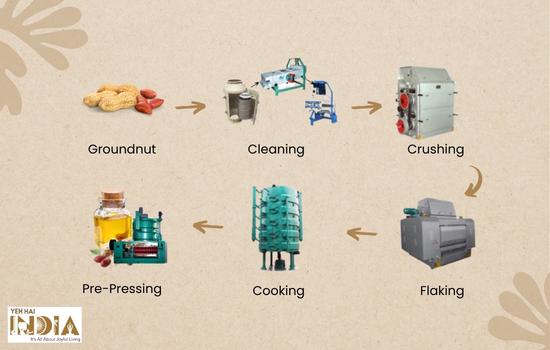
Preprocessing:
In the initial step, the kernels containing peanuts are cleaned to eliminate excess dirt from their surface. They are then shelled to remove the external hard surfaces and barks.
The pods are cracked and cooked under controlled physical conditions using specialized seed processing equipment.
Pre-pressing
One of the crucial stages in oil production is pre-pressing. The kernels are expelled and the peanut oil is extracted using screw oil press machinery units.
However, due to the high residue content, the solvent extraction process is employed to obtain pure and residue-free oil.
Filtering and Refining
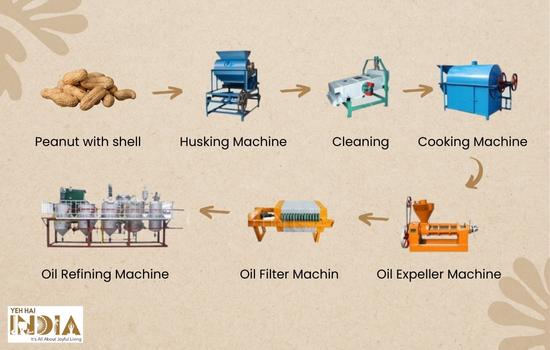
The oil obtained from pre-pressing is referred to as crude peanut oil. To remove residues and other compounds, the oil undergoes filtering and refining processes.
Filtering involves separating insoluble particles from crude oil. Since the oil still contains various soluble impurities, it is necessary to further refine it in refineries.
Types of Groundnut Oil
Refined groundnut oil
This type of oil undergoes the process described earlier. The crude oil undergoes to multiple filtering and refining steps to increase its transparency. This leads to the filtration of both soluble and insoluble impurities. However, some essential compounds may also be eliminated during the refining process.
Cold-pressed or extra virgin groundnut oil
In this method, no heat is used during oil extraction. The solvent extraction process ensures that the resulting oil is pure, preserving its original texture, flavour, and aroma. Cold-pressed peanut oil is of high value and expensive due to retaining all the natural flavours and aromas of the nut.
Peanut oil blends
Due to high cost, manufacturers blend it with lower-cost oils with similar smoking points. This blending lowers the price, making it more affordable. The low-cost oil is carefully mixed in the right proportion to maintain the original flavour and aroma of the nut oil.
Roasted groundnut oil
In this type, the kernels are first roasted until they turn golden brown. Subsequently, they go to pressing units for oil extraction.
The roasting process enhances the nutty flavour of the oil and imparts a golden brown colour, distinguishing it from the pale yellow hue of other varieties.
Why is it used in Cooking?

Groundnut oil is widely popular across India for cooking purposes because of the following reasons:
Flavour
Its light, nutty flavour doesn’t overpower other ingredients when used for deep-frying, pan-frying, or sautéing.
High Smoke Point
It can be used for cooking under high heat without burning. It has a high smoke point of 450°F.
Great Substitute for Refined Oils
It is a good substitute for refined oils in Indian cooking because refined oils with high polyunsaturated fatty acid (PUFA) content can easily degrade into toxic compounds when exposed to high temperatures.
Recommended Article: Refined vs Unrefined oil: Which one is the best for your health?
The Flavour of the Regional Cuisines
Groundnut oil plays a prominent role in many regional cuisines. For example, in South India, it is a part of the preparation of dishes like sambar, rasam, and various chutneys.
In North India, it is used for making sweets like laddoos, as well as for preparing gravies, curries, and biryanis.
It is also commonly a part of Indian street food preparations. For instance, it is used for frying popular snacks like pakoras (fritters), bhajiyas, and vadas (savoury lentil or vegetable fritters).
The use of groundnut oil lends a distinct flavour and texture to these street food delights. Its high saturation content produces a crisp exterior and moist centre.
It is versatile and used in various Indian dishes such as
- Mixed Sprouts Poha,
- Chana Dal Pancakes,
- Moong Dal Chilla,
- Indian Oats Pancake with Jowar,
- High Fiber Chillas,
- Paneer Veggie Wraps,
- Jowar aur Pudina ki Roti,
- Jowar Pyaz ki Roti,
- Methi Thepla,
- Broccoli and Paneer Tikki, Paneer Pudina Tikki, Corn and Potato Tikkis,
- Green Peas Potato and Paneer Cutlet, and
- Ragda Patties.
Traditional Dishes
Many traditional Indian recipes have groundnut oil as an integral ingredient. It is a crucial component in dishes like Gujarati dal (lentil stew), Andhra-style peanut chutney, Bengali shorshe bata (mustard paste), and Maharashtrian shengdana chi amti (groundnut curry).
Sweets & Desserts
Groundnut oil finds its way into various Indian sweets and desserts. It is an important ingredient in the preparation of traditional sweets like chikki (peanut brittle), halwa (sweet pudding), and barfi (fudge). Groundnut oil imparts a rich flavour and creamy texture to these delectable treats.
Pickles
Groundnut oil is common in the preservation of pickles in Indian households. The oil acts as a preservative, protecting the pickles from spoilage and adding a distinctive flavour to the pickling process.
Note: A highly refined peanut oil can potentially contain traces of hexane, a neurotoxin. Quality control is crucial to prevent contamination with aflatoxin, a highly toxic substance produced by mould-infected peanuts.
Health Benefits of Groundnut Oil

Groundnut oil consists of different fatty acids categorized as saturated, monounsaturated, and polyunsaturated fats. It is free of bad cholesterol, trans fats and has a very low saturated fat content.
Consuming moderate amounts of monounsaturated and polyunsaturated fats, while replacing saturated or trans fats, can help lower cholesterol levels and reduce the risk of heart disease.
Groundnut oil contains 17% saturated fat, 46% monounsaturated fat, and 32% polyunsaturated fat, a heart-friendly combination.
Heart health:
Research suggests that regular consumption of groundnut oil may lower the risk of heart-related conditions and reduce cholesterol levels.
Cancer prevention:
Groundnut oil contains phytochemicals that may have a protective role against colon, breast, and prostate cancer.
Brain health:
The presence of vitamin E, B3, and resveratrol in groundnut oil may contribute to brain health and potentially protect against Alzheimer’s disease.
Diabetes management:
Some studies indicate that groundnut oil may have a positive impact on diabetes by enhancing insulin production and reducing glucose levels.
Rich in Vitamin E:
It is a rich source of vitamin E, which helps strengthen immunity.
Dangers in Groundnut Oil

Peanut Allergy:
Groundnut oil can cause allergic reactions in individuals with peanut allergy. Refined peanut oil, with all proteins removed, may be less likely to cause allergies. However, if the oil contains peanut protein, there is a risk of allergic reactions.
High-Calorie Content:
Like all oils, groundnut oil is calorie-dense. It provides 9 calories per gram, so excessive consumption can contribute to weight gain if not consumed in moderation.
Omega-6 Fatty Acids:
Groundnut oil is relatively high in omega-6 fatty acids, which are essential but need to be balanced with omega-3 fatty acids for optimal health. An imbalance between omega-6 and omega-3 fatty acids in the diet may contribute to inflammation and certain health conditions.
Processing Methods:
The quality of groundnut oil can vary depending on the processing methods used. Refined groundnut oil undergoes refining processes that may involve heat, chemicals, or filtration, which can impact the nutritional value and overall quality of the oil. Cold-pressed or unrefined groundnut oil is considered to retain more of its natural nutrients.
Alternate Choices for Groundnut Oil
Apart from Groundnut oil, find out which other oils are good.
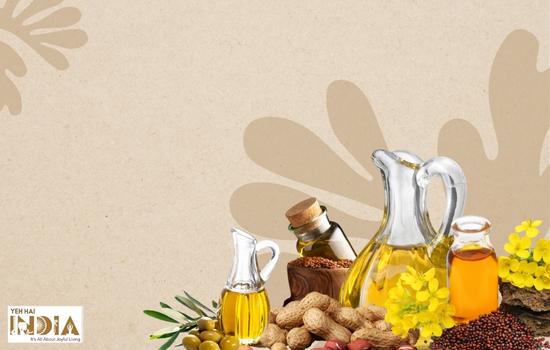
Olive Oil:
Research suggests that olive oil consumption provides various health benefits and reduces the risk of coronary heart disease (CHD). However, olive oil may not be ideal for Indian cooking due to its suboptimal ratio of omega-6 to omega-3 fatty acids (N6:N3 ratio).
Mustard oil:
It is a healthy edible oil due to its low saturated fatty acid (SFA) content, high monounsaturated fatty acid (MUFA) and polyunsaturated fatty acid (PUFA) content, and a favourable N6:N3 ratio (6:5).
It is available in a non-refined (cold-pressed) form and remains relatively stable during cooking at high temperatures.
Several studies suggest that mustard oil may be associated with a lower risk of CHD compared to other oils. A study reported a 71% reduction in CHD risk among individuals using mustard oil for frying.
Another study demonstrated that acute myocardial infarction patients using mustard oil experienced a reduction in arrhythmias, heart failure, and angina.
Flaxseed Oil:
Although a rich source of alpha-linolenic acid (ALNA), it is not commonly consumed on its own. Blending flaxseed oil with other edible oils is a recommended strategy to increase ALNA intake.
Blending of Oils
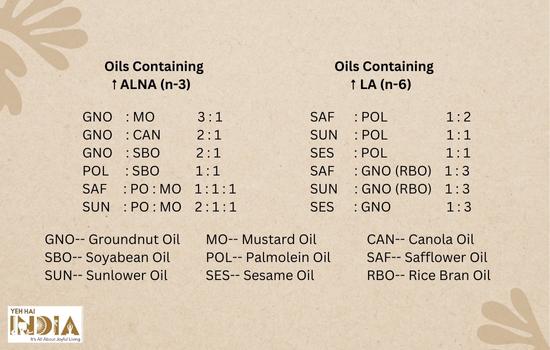
FREQUENTLY ASKED QUESTIONS
Is groundnut oil the same as peanut oil?
Yes, groundnut oil and peanut oil refer to the same oil. The terms are interchangeable to describe the oil from peanuts (groundnuts).
Is groundnut oil suitable for people with peanut allergies?
People with peanut allergies should avoid consuming groundnut oil as it comes from peanuts and can potentially trigger an allergic reaction. It is important to consult with an allergist or healthcare professional for specific advice.
What is the difference between refined and cold-pressed groundnut oil?
Refined groundnut oil undergoes a refining process that involves filtering, bleaching, and deodorizing. Cold-pressed groundnut oil, on the other hand, comes from extracting through a mechanical process without the use of heat or chemicals, preserving more of its natural nutrients. Cold-pressed or virgin groundnut oil is generally a healthier option.
How to safely store groundnut oil?
Safely store groundnut oil in a cool, dark place away from direct sunlight to maintain its quality. It is important to seal the oil tightly to prevent oxidation and prolong its shelf life.
REFERENCES:
- Peanuts as functional food: a review – NCBI
- Selecting healthy edible oil in the Indian context – NCBI
- Groundnut oil for cooking: Popular options for Indian cooking needs (June 2023, TOI)
- Effect of Dietary Substitution of Groundnut Oil on Blood Glucose, Lipid Profile, and Redox Status in Streptozotocin-diabetic Rats – NCBI
- Srilaxmi Book of Dietetics
Also Read: Olive Oil Benefits: Amazing Qualities Beyond Flavour










